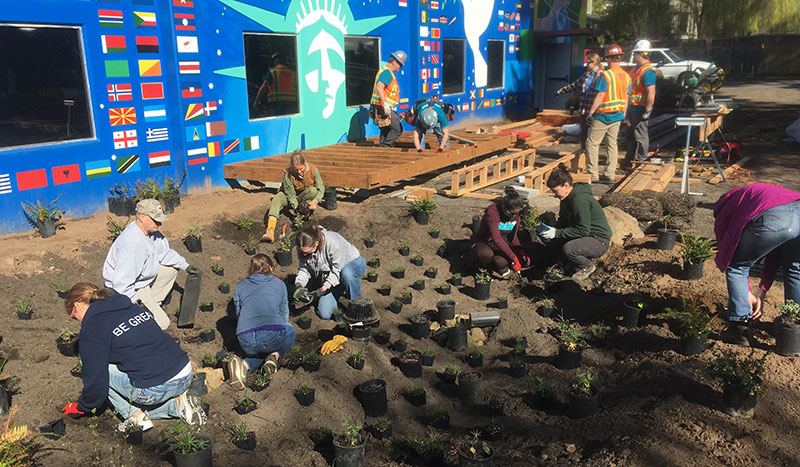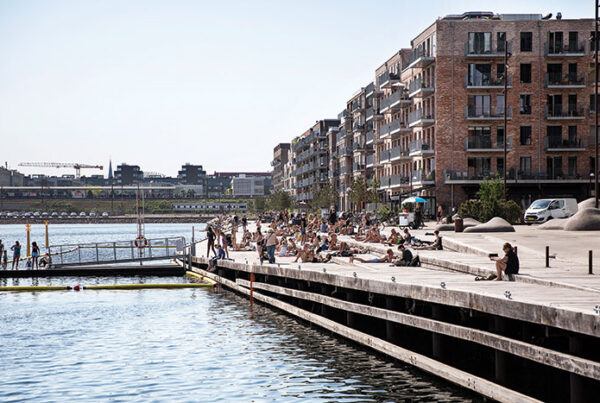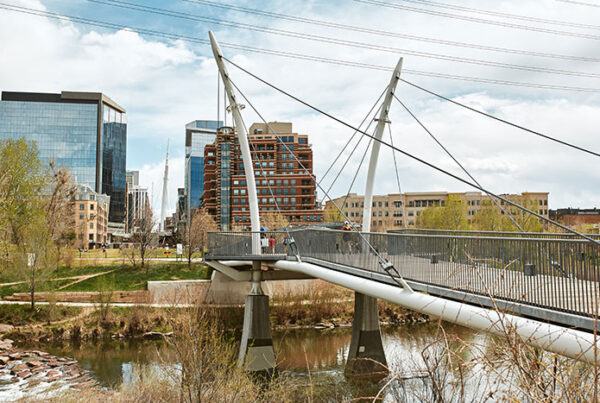For more than 50 years, Earth Day has been observed a day of mobilization for environmental protection and preservation. This week, it is celebrated by ULI, environmental stewardship organizations, and other organizations working to enhance the built environment and implement solutions to make communities more green, healthy, and equitable.
This year’s Earth Day theme, “Restore Our Earth,” presents an opportunity to share examples of ULI’s efforts to drive progress toward a more sustainable future for the real estate industry. The ULI Center for Sustainability and Economic Performance’s program of work includes many elements that tie into the Earth Day theme.

As part of a TedX conference in Amsterdam focused on equity, a pop-up coffee shop and pavilion were constructed in the Zuidas District as a proof of concept for the circular economy. (TEDxAmsterdamWomen/Flickr)
Circular Economy to Restore Our Earth
The ULI Greenprint Center for Building Performance provides the real estate industry with thoughtful and intentional leadership on the business case for green buildings, including an emphasis on the circular economy. In a circular economy, material waste is minimized. Circular design principles in the buildings sector aim to reduce, reuse, and recycle materials during the building’s life cycle, from construction to operations to end-of-life.
By incorporating circular-economy design principles into development decision-making, the real estate sector can reduce waste as well as reuse and recycle materials. In this way, and by extending the lifecycle of building materials, the industry can minimize the amount of waste that ends up in landfills.
As building materials become more scarce and expensive, reusing those materials opens a new value stream for buildings during deconstruction and creates a steady flow of low-carbon materials for new buildings. ULI’s Sustainability Outlook 2021 highlights a study featuring the successful financial performance of five European cities that implemented circular-economy frameworks.
In the Netherlands, circularity goals provide an excellent example of circular economy implementation in action. With a national goal of reaching 100 percent circulatory by 2030, many buildings in the Netherlands are already being designed with circular-economy principles in mind.
Circl, a 35,000-square-foot (3,300 sq m) pavilion space developed by Dutch bank ABN AMRO in Amsterdam, is at the forefront of the circular-economy design movement, taking into consideration every aspect of the embodied carbon and life-cycle footprint of the site. The building, which received a 2020 ULI Europe Award for Excellence, was designed for use of as few new materials as possible and boasts cutting-edge reused and recycled interior design features, including reclaimed hardwood floors from more than 15 different buildings, reused office windows, and recycled blue jeans that act as insulation and soundproofing material.

As part of a multifaceted policy and infrastructure effort to address flooding, the City of Miami Beach, Florida. has embraced living shorelines and green infrastructure strategies in many of the city’s parks and open spaces, including the Muss Park Seawall Enhancement project. (Shutterstock)
Natural Design Solutions to Restore Our Earth
At the community scale, the ULI Urban Resilience program has been working with local governments and ULI members to prepare for potential climate hazards by integrating restorative and nature-based design strategies into their communities. The Urban Resilience program partnered with the Southeast Florida Regional Climate Change Compact, a partnership between Broward, Miami-Dade, Monroe, and Palm Beach counties, to drive rehabilitative shoreline design and climate adaptation strategies in Southeast Florida. The results, summarized in The Business Case for Resilience in Southeast Florida report, articulate the clear case for investing in resilient infrastructure, including nature-based solutions that provide benefits for environmental and community quality of life.
ULI’s previous Advisory Services program work in Southeast Florida also emphasizes the importance of incorporating living shorelines and other green infrastructure features such as mangroves, rain gardens, bioswales, and native aquatic vegetation in the landscape to protect waterfront property from flooding, erosion, and the impacts of storm surge. As part of a multifaceted policy and infrastructure effort to address flooding, Miami Beach has embraced living shorelines and green infrastructure strategies in many of the city’s parks and open spaces, including the Muss Park Seawall Enhancement project. The park was designed to protect the longevity of existing mangroves while supporting the biodiversity of surrounding ecosystems.

In Portland, Oregon, nonprofit Depave Gardening has been repurposiing impervious pavement into murals, green space and other multi-functional uses. (Depave Gardening/Katya Reyna)
Living-shoreline design techniques can be seen in inland communities as well. For instance, Buffalo Bayou Park in Houston uses natural design methods to manage rainwater and reduce impacts of flooding from climate events. The park, occupying 2,500 acres (1,000 ha) in downtown Houston and set to be completed in 2022, won a ULI Global Award of Excellence in 2017. The park offers significant recreational green space and features native plants that aid in protecting Houston’s people and assets from climate events, including hurricanes and intense storms.
Parks and Green Space to Restore Our Earth
Investing in parks and green space that promote economic and environmental revitalization while enhancing neighborhood connectivity is vital as we emerge into a post-pandemic world.
This year the Building Healthy Places Initiative has been helping ULI members understand opportunities to enhance community-wide environmental health, wellness, and social equity through the creation of high-quality parks and open spaces.
The pandemic itself has spurred governments around the world to think creatively about how public spaces—including space previously reserved for automobiles—can better serve the needs of people. The new report The Pandemic and the Public Realm: Global Innovations for Health, Social Equity, and Sustainability features more than 30 innovative public-space programs and projects created since COVID-19 public health measures began in spring 2020. It showcases how temporary, flexible, equitable, and iterative projects can respond to quickly changing needs while building support for future projects in the recovery.
Another recently released report, 10 Principles for Enhancing Equitable Access to Parks, emphasizes the importance of community empowerment and the role that community members have in participating in neighborhood decision-making processes. Domino Park in Brooklyn, New York, is profiled in the report. Through a process that included extensive outreach and community engagement, Domino Park was transformed into an accessible five-acre open space. Today, the Brooklyn park houses native plants that reduce stormwater runoff and aid in mitigating the impacts of sea-level rise, as well as provides neighborhood connectivity and open space to its home neighborhood of Williamsburg.
ULI’s Building Healthy Places work also highlights the benefits of transforming impervious surfaces like parking lots and roadways into accessible park space. The Pavement to Parks report homes in on work Portland, Oregon, by Depave, a nonprofit focused on transforming impervious pavement into equitable parks and open space.
In 2018, the organization partnered with Portland’s Boys and Girls Clubs to transform a 4,500-square-foot (420 sq m) parking lot into a nature play area and educational rain garden. Today, the space is used as an outdoor learning space for over 200 children and has pervious surfaces that enhance rainwater management strategies and promote better environmental conditions for the community.
As this work shows, opportunities for restoring the Earth by more sustainably using building materials, enhancing resilience, and creating equitable parks and public spaces are abundant.
Want to learn more about the ULI Center for Sustainability and Economic Performance? Sign up for our newsletter at uli.org/sustainability.



